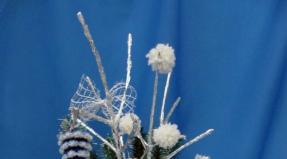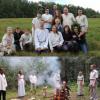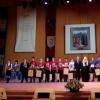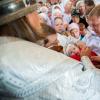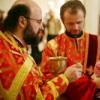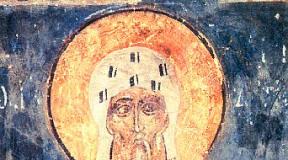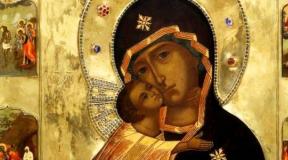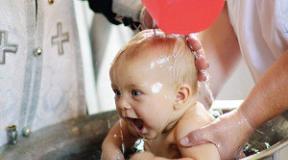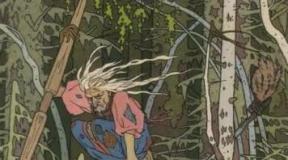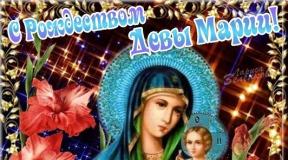Island of kefalonia greece monastery snakes assumption. "Virgin of the Serpent" and the Goddess with snakes
Miracle with snakes on the island of Kefalonia - exposure September 2nd, 2015
Orthodox often mention in addition to blessed fire
another regular miracle.
On the day of the Assumption of the Blessed Virgin Mary in the Church of the Assumption of the Blessed Virgin Mary (on the Island of Kefalonia) to her miraculous icon of Panagia Fedus, in the village of Markopulo, they miraculously crawl Poisonous snakes to glorify the Mother of God together with all believers."
Another source points out another striking detail: “They are gray in color, thin. They do not exceed one meter in length, their skin is velvety. they have a cross on their head
like on the tip of the tongue."
There is also a documentary about this phenomenon.
How does everything really happen?
1. Crosses on the heads of snakes?
Thanks to the presence of the documentary, it is easy to see that they do not have any crosses on their heads.
2. Where do snakes come from?
Already in one of the Orthodox articles cited here, it was written that “These days the inhabitants of Markopulo walk along the ravine, on the slope of which the church is located, and collect snakes to bring them to the Most Holy Theotokos.” Some incredulous pilgrims asked local priests about the origin of snakes, and they did not hide the fact that they themselves collect them:
« I visited this monastery 2 years ago
. We tortured the ministers with questions: "Are snakes really crawling by themselves?" Unable to withstand our addiction, they reported that people bring them. ( tatiana_ilinka)
Her words are confirmed by another participant ( aa_ksantino) “Good afternoon, father! tatiana_ilinka is absolutely right - these snakes are simply brought to the holiday, they do not crawl into the temple at all, as is often presented on Orthodox sites. The story of the snakes, alas, is a pious tale.”
Yet one story confirming that kites are simply brought ( popadya): “Actually: These snakes are representatives of the local fauna, absolutely harmless creatures, like our snakes. Of all the things told, the only truth is that most of them actually have a pattern on their heads that looks a lot like a four-pointed cross. The rest are pious lies. They do not crawl into the temple, unless by chance - the doors are open, they can crawl. For the service, the servants of the temple go to the nearest forest, pick up these snakes there in large boxes and bring them to the temple. Everything. No one has examined them, they are not poisonous, they do not disappear anywhere, but all the time they live in the vicinity of the temple.
3. Are these snakes poisonous?
As witnesses have previously reported, these snakes are ordinary, non-poisonous. From the photo it is easy to determine the species of these snakes. This is a cross-striped snake.
In this way.
They bring snakes.
They are not poisonous.
There are no crosses on their heads.
In the eastern part of Kefalonia (Island in the Ionian Sea), not far from the village of Markopoulo, there is a small church dedicated to the Assumption of the Blessed Virgin Mary. Here, for many years, something unusual has been happening every year on the feast of the Assumption. Since the Transfiguration, snakes appear inside and outside the temple. The locals call them snakes of the Blessed Virgin Mary.

Previously, in previous years, the number of snakes increased every day, and on the eve of the Assumption, they filled the entire district. These days, the inhabitants of Markopulo walk along the ravine, on the slope of which the church is located, and collect snakes to bring them to the Most Holy Theotokos. Where the snakes come from and where they disappear after the holiday, no one knows. To this day, it remains a great mystery to everyone.
The Dormition of the Mother of God is called the second Easter here. August is the month of the Virgin. The inhabitants of the village of Markupolo, of which there are no more than 30, have been helping in the temple since the very morning. In line, pilgrims from all over the world who want to see the miracle barely fit in the small square near the church.
During the all-night vigil, snakes crawl freely among people - along the stasidia, lecterns, without being afraid of anyone. “If a snake crawls into your bosom,” the villagers warn pilgrims or tourists, “do not be afraid! By the grace of the Most Holy Lady of the Mother of God, snakes will not cause you any harm. Pick them up and they will lick your fingers like kittens.
Indeed, incredible things happen during the service: snakes, like bracelets, wrap around the hands of believers, crawl over the icon of the Most Holy Theotokos and the Crucifixion, over the bread prepared for the litia. The snake can even crawl onto the Gospel, which is read at the Liturgy. Snakes, as representatives of the animal kingdom, celebrate together with Christians, reminding them of the Garden of Eden, in which primitive people lived with animals as a single family. At the end of the holiday, the snakes also leave.
German scientists investigated these snakes, but could not attribute them to any of the known species. They are gray and thin. In length, they do not exceed one meter, their skin is velvety. They have a cross on their head, as well as on the tip of the tongue.
If in any of the years snakes did not appear, this was always a bad omen. So it was in 1940 and 1953, when strong earthquakes occurred on the island.
The island of Kefalonia is called the “Island of Miracles”, since it is here that miracles known throughout the Orthodox world take place on the feast of the Assumption of the Blessed Virgin Mary. On this day, poisonous snakes miraculously crawl to the Church of the Assumption of the Most Holy Theotokos to Her miraculous icon of Panagia Fedus, in the village of Markopulo, to glorify the Mother of God together with all believers.
Every year on the eve of the Assumption of the Mother of God, a small earthquake (3-4 points) occurs on the island, and on the very day of the holiday it rains, which is very rare here at this time of the year. But this is not the main miracle, but its harbinger. On the day of the Annunciation of the Most Holy Theotokos, the Kefalonians bring white lilies to the temple, similar to the one with which the Archangel Gabriel appeared to Her. These flowers are put into the kiot of the icon of the Mother of God "Panagia-Krini", where they remain without water until the feast of the Assumption of the Virgin. And here a marvelous thing happens: pale white flowers bloom on dry, heat-cracked stems of lilies - and this is five months after they were cut! On the feast of the Assumption of the Mother of God, after the Liturgy, a prayer service is served in the church, flowers are blessed and distributed to the faithful who came to the church that day. These dry stems of lilies are like our souls, withered from unbelief and doubt. The snow-white flower, as it were, reminds us that nothing is impossible for God and that our soul, mired in sins, can also blossom and be illuminated by the grace of God.
It should be noted that lilies are biblical flowers. In the Gospel of Matthew, the Lord Himself testifies to this: “Look at the lilies of the field, how they grow: they neither work nor spin; but I tell you that even Solomon in all his glory did not dress like one of them” (Matthew 6:29).
And in another temple on this day, near Her miraculous icon of Panagia Krini, living lilies bloom again on the dried stems of flowers that believers bring to the feast of the Annunciation. In one of the monasteries on this island, the right foot of the holy Apostle Andrew the First-Called is kept.
Pilgrims also visit the monastery of St. Gerasimos of Kefalonia, who labored on the island in the 16th century. This saint is the heavenly patron not only of the island of Kefalonia itself, but of all the Ionian Islands. The veneration of St. Gerasimos can be compared with the veneration of St. Seraphim of Sarov both in Russia and in Greece. 
Kefalonia is the largest island of the Ionian Sea, with an area of 737 sq. km., located between the islands of Zakynthos and Lefkada. Kefalonia is the first point on the way to Italy, and, accordingly, has always been of interest to those travelers who want to follow the path of the legendary Odysseus, as well as just get acquainted with the beauties of the Aegean Sea. The island seems to rise from the sea, gradually appearing on the horizon. First, the traveler sees the Aenos mountain range, surrounded by black pine trees, and then the island itself appears - endless bays and luxurious beaches, surrounded by the dark blue waters of the Aegean Sea. It is an island full of secrets, contrasts and surprises, derived from its geological structure and the peculiar nature of its inhabitants. The inhabitants of Kefalonia travel a lot, they are strong, active and practical people, combining softness and rudeness, courtesy and cheeky humor, they are very hospitable people, who once won their favor will always feel at home here.
Argostili, the capital of the island, is a modern city with a rich cultural heritage. Among the most significant geological phenomena is the Melissani Cave, an underground lake with wild pigeons flying out from there as soon as the sun's rays penetrate through wide openings. Another attraction is the Drogarati cave with red stalagmites and stalactites. A strange spectacle can be seen in Argostili - this is the cave of Agia Theodori, where huge amounts of sea water come to the ground and disappear into the earth's crevices in order to reappear after passing underground 17 km., in Sami in Lake Melissani. In the north of the island, in Paliki, there is another interesting phenomenon - Kunopetra - a rhythmically swaying rock ...
Flowers and fruit trees cover the island, filling it with exceptional aromas. Many birds live here: ducks, herons and swans, which usually nest in the Livadi Bay in Lixouri and in the Koutavas Lagoon in Argostili. The famous Caretta-Caretta turtle lays its eggs on the southern coast of the island, and Mediterranean seals live in the northern cliffs.
History.
Kefalonia, as well as Ithaca, Zakynthos and Lefkada, flourished during the Mycenaean period, when the inhabitants of these islands traveled extensively. In the classical era, Kefalonia was divided into 4 administrative districts (today it is Krani, Sami, Pali and Proni) named after the four sons of the hero Kefalos, whose name the island began to bear. During the Dorian period, the wars continued, as a result of which many fortifications were erected on the island. During the Byzantine period, exorbitant taxes were imposed on the inhabitants of the island, and at the same time the island was constantly attacked by pirates. During the Norman Conquest, Kefalonia was designated as the administrative center. After the French and Venetian occupation, the island was taken over by the Turks, causing terrible destruction. The Venetian rule was characterized by the emergence of class differences, which became an important milestone in the history of the island, starting from 1500. From that time until 1797, Kefalonia became an important strategic point for the Venetian fleet. In 1757 the capital was moved to the city of Argostili. Since then, the island has passed to the French, who were met here as liberators. Despite the unrest and the conquest of the island, Kefalonia began to develop rapidly economically and intellectually. After some time, Kefalonia went to the Turks. Since 1809, British rule has been established. The famous Drapanos stone bridge connecting Argostili with the opposite bank was built in 1813. In 1815, a treaty was signed under which the island came under British protection. Kefalonia, along with some other Ionian islands, was annexed to Greece in 1864. Over time, after numerous conquests, the Ionian Islands have accumulated a huge historical heritage, after which many historians began to call them the "Civilization of the Seven Islands". This fact left its mark on the characters of the people living on these islands.
Kefalonia is the island of St. Apostle Paul! In 59, a Roman ship was carrying St. Apostle Paul from Caesarea to Rome for trial, on the way they were overtaken by a storm near Malta, where St. the apostle stayed three months. At this point, we should pause and turn our attention.
On about. Kefalonia there are two temples, from the Byzantine period, in honor of St. Apostle Paul! (according to the Greek tradition, temples and monasteries have several names 1 - official - canonical, 2 - folk in honor of some historical event, and the folk name also tends to change over time) despite their many centuries of history, temples have never changed their original name , and even on the territory of western Greece, these are the only ancient temples in honor of St. apostle Paul. The very location of the temples on the island already speaks volumes! One temple is located in Pessada, the place where the center of the preaching of the apostle was, the second temple is located on the site where in ancient times there was a port from which ships sailed to modern Italy.
The Synod of the Church of Greece in 2000 officially ranked the Church of Kefalonia among the churches founded by St. apostle Paul.
In Kefalonia, the Grace of God and piety have never stopped since apostolic times: an example of this is the many churches and holy monasteries in which miracles and inexplicable phenomena for today's science take place!
Monastery of the Assumption of the Blessed Virgin, or Fidetis.
In the east of Kefalonia there is a small nunnery, its appearance is associated with the miracle of finding the icon of the Most Holy Theotokos. Somehow, the inhabitants of the nearest village saw that the forest was burning in their immediate vicinity. When the alarmed residents came to fight the fire, they saw only one burnt tree. And under it was the icon of the Most Holy Theotokos absolutely untouched by fire. With great reverence they endured St. the image to his village church, but the next morning the icon was not in it. She was found again in the same place under a burnt tree, after some time a temple was built there, and cells began to appear near it, and so a convent was formed!
Many miracles happened from St. image, but the most impressive thing for everyone, both believer and non-believer, is the miracle associated with snakes! The nuns of the monastery, seeing the approaching danger in the face of pirates who wanted to rob and abuse the defenseless nuns, then the sisters of St. the monastery in a prayer petition turned to their Intercessor of the Most Holy Theotokos, the pirates approached the monastery and stumbled upon the formidable defenders of the monastery - they were snakes! Until today, every year on the feast of the Assumption of the Blessed Virgin Mary, snakes appear in the monastery. No one knows where they hide all year round, where they crawl out from and where they go later, they crawl everywhere and even on pilgrims who have come. As the locals say, these are the snakes of the Blessed Virgin, and if they crawl on you, do not be afraid! You can pick them up and they will lick your hands like kittens! So every year the Most Holy Theotokos glorifies Her monastery and humble nuns!

Monastery of the Holy Mother of God Koronatu or Dakrygusas.
At the end of the 15th century, noble blood Leon Polikalas moved from the Peloponnese region of Koroni to Kefalonia. He brought with him the icon of the Most Holy Theotokos, which was left with honors in the temple for general worship, and there she was until a strong earthquake destroyed the temple. A century later, a shepherd from a nearby settlement miraculously found St. an icon hanging on a tree in a dazzling radiance!
Several times the image of the Most Holy Theotokos disappeared from his house and ended up at the place of acquisition, after which the shepherd had to tell his fellow villagers about what had happened, and after some time a church was built on this place again!
Gradually, over time, monastic cells began to appear near the temple, thanks to the labors and cares of the inhabitants, the monastery turned into an oasis of the soul and spiritual!
The monastery celebrates three times:
August 15 - Assumption of the Blessed Virgin Mary,
January 23 - Holy Mother of God Koronatu or Dakrygusas, salvation of the monastery from the earthquake in 1967
July 2 - Blachernae icon of the Most Holy Theotokos (icon of the Virgin Robe of Isaiah) The Athos charter is preserved in the monastery.
Holy monastery Kipureon

The place on which today's monastery stands has always been holy, hermit monks labored here. If you point your feet here, you will understand why! The nature of this place itself makes you think about eternity. The temple in honor of the Annunciation of the Most Holy Theotokos was built in 1759, at the time of its heyday the brethren consisted of 80 people. The history of the monastery of the 20th century is unfortunately very tragic, so by mistake in 1915 the monastery was fired upon by a French cruiser, causing great destruction. The earthquake of 1953 destroyed almost all the buildings. But despite this, in 1964 the temple was restored, and in the 90s the buildings were rebuilt.
Great Orthodox shrines are kept in the holy monastery, the heads of the founders of the monastery of St. Chrysantha, St. Constantine and St. Euphrosyne, the miraculous icon of the Annunciation of the Most Holy Theotokos, near which everyone who asks receives the Blessing of the Mother of God, a particle of the Cross of the Lord - which was donated to the monastery by Vladimir Dolgoruky in 1862. Myrrh with the relics of St. Demetrius of Thessalonica, miraculous icon of St. Paraskeva, and particles of the holy saints of God!
Holy Monastery of the Most Holy Theotokos Sision.
The monastery was founded in the 13th century by Francis of Assisia.
Initially, the monastery was subordinate to the Latin bishopric of the island of Kefalonia. During the Middle Ages, Orthodox monks also appeared in the monastery, in subsequent centuries the monastery became completely Orthodox. The miraculous icon of the Most Holy Theotokos Sision of the 15th century is kept in the monastery. The altar icons of the temple are a great cultural heritage of the region.
Temple Leading to the Church of the Blessed Virgin Mary
The gilded dome is not a single attraction; the coffin and a particle of the relics of St. Martyr Patriarch Gregory 5 of Constantinople, who was hanged by the Turks on April 10, 1821 on the greatest feast of Easter, on the gates of the temple, which remain closed to this day in memory of St. patriarch. The quiet and cozy temple disposes those who come to prayerful contemplation.
Church of St. Paraskevi, Metochion of the Monastery of the Holy Mother of God Koronatu or Dakrygusas.
At the temple there are cells for the nuns of the monastery. The miraculous icon of St. Paraskeva, a huge collection of particles of relics, also the relics of the newly-appeared Saint Panag 1801 - 1888. nun Agathia worked very hard collecting everything related to the saint, and when there was a meeting on the issue of glorification to the saints, the materials collected by nun Agathia greatly accelerated this process.
Monastery – Saint Gerasimos From the first centuries of Christianity near Mount Omalon in a beautiful valley there was a monastery with the name of Holy Jerusalem, during the Middle Ages it ceased to exist, what was the reason for this, we do not know. But the Lord does not leave those places where the righteous served Him, so in 1560 the monk Gerasimos came here. He came from a noble Byzantine family, which was related to the Palaiologos family. After St. Gerasimos received a higher education of that time, he went to Constantinople, Athos, Crete and the island of Zakynthos. After his journey, St. Gerasimos came to the island of Kefalonia in the region of Lassi in 1555 and asceticised in a cave, in which today there is a small temple. After 5 years, the Lord brought His saint to the site of the former ancient monastery, so that the place would be glorified again and the Grace of God would spread. Here St. Gerasimos not only saved his soul, but also taught people to preserve Orthodoxy from the violence of Catholic domination on the island, taught children to read and write, planting plane trees and caring for the place.
From the first centuries of Christianity near Mount Omalon in a beautiful valley there was a monastery with the name of Holy Jerusalem, during the Middle Ages it ceased to exist, what was the reason for this, we do not know. But the Lord does not leave those places where the righteous served Him, so in 1560 the monk Gerasimos came here. He came from a noble Byzantine family, which was related to the Palaiologos family. After St. Gerasimos received a higher education of that time, he went to Constantinople, Athos, Crete and the island of Zakynthos. After his journey, St. Gerasimos came to the island of Kefalonia in the region of Lassi in 1555 and asceticised in a cave, in which today there is a small temple. After 5 years, the Lord brought His saint to the site of the former ancient monastery, so that the place would be glorified again and the Grace of God would spread. Here St. Gerasimos not only saved his soul, but also taught people to preserve Orthodoxy from the violence of Catholic domination on the island, taught children to read and write, planting plane trees and caring for the place.
In 1579 Saint Gerasimos reposed in the Lord, and in 1622 the patriarchal synod glorified him among the saints.
The relics of the saint are kept in the monastery church, where miracles often occur.
From the monastery there is an entrance to the cave where St. Gerasimos. Everyone can enter there, but the entrance is very narrow, you have to literally crawl through it. It is here that a miracle happens: anyone who wants to can fit in the passage, and no one has yet gotten dirty from the earth and dust at the entrance to the cave.
http://www.logoslovo.ru/forum/all/topic_7748/
In Greece, on the island of Kefalonia, or the “Island of Miracles,” as it is called, every year in August, poisonous snakes crawl to the Church of the Assumption of the Blessed Virgin Mary, in the village of Markopoulo, where the miraculous icon of Panagia Fedus (translated as “Our Lady of the Serpents”) is located. . Believers call them “the snakes of the Virgin Mary”, because on this day they are harmless. They do not exceed one meter in length, they have a cross on their head, as well as on the tip of the tongue. According to tradition, if snakes do not appear, this is a bad sign. This happened twice - in 1940 before the outbreak of World War II in Greece and in 1953 - before the destruction of solid earthquake.
There were no snakes this year :(
.
Panagia Fedus Icon of the Mother of God
Villagers notice snakes on the eve of the holiday, often gather with the priest in advance, read prayers and expect the appearance of snakes. Small snakes crawl here, and they are brought to the temple for Divine service. They are collected, put on the neck and stroked. Orthodox Greeks believe that this touch brings happiness. During the festive service, snakes are placed on the icon of the Mother of God, and they lie quietly there throughout the not-so-short service.
During the all-night vigil, snakes crawl freely among people - along the stasidia, lecterns, without fearing anyone. - If a snake crawls into your bosom, - the villagers warn pilgrims or tourists, - do not be afraid! By the grace of the Most Holy Lady of the Mother of God, snakes will not cause you any harm. Pick them up and they will lick your fingers like kittens.
According to ancient tradition, snakes are left in the church all night.
Indeed, incredible things happen during the service: snakes, like bracelets, wrap around the hands of believers, crawl over the icon of the Most Holy Theotokos and the Crucifixion, over the bread prepared for the litia. The snake can even crawl onto the Gospel, which is read at the Liturgy.
Snakes, as representatives of the animal kingdom, celebrate together with Christians, reminding them of the Garden of Eden, in which primitive people lived with animals as a single family. At the end of the holiday, the snakes also leave.
Where the snakes come from and where they disappear after the holiday, no one knows. To this day, it remains a great mystery to everyone.
German scientists investigated these snakes, but could not attribute them to any of the known species. They are gray and thin. In length, they do not exceed one meter, their skin is velvety. They have a cross on their head, as well as on the tip of the tongue.
Snakes are mentioned in Christian books, mostly with a negative connotation, but Kefalonia is practically the only place in the world where these reptiles seem to be rehabilitated in the eyes of believing Christians.
But the Orthodox Cephalonians during the celebration of the Assumption of the Virgin are not at all afraid of snakes. And the snakes annually crawl out to the temple on August 28 for a holiday. On this day, the centuries-old enmity that arose after the fall in Paradise disappears. Kefallonians and tourists hold the snakes in their arms without fear, put them on their shoulders and they playfully crawl over them.
Every year on the eve of the Assumption of the Mother of God, a small earthquake (3-4 points) occurs on the island, and on the very day of the holiday it rains, which is very rare here at this time of the year.
But this is not the main miracle, but its harbinger.
For four and a half months, on the day of the Annunciation of the Most Holy Theotokos, the Kefalonians bring white lilies to the temple, similar to the one with which the Archangel Gabriel appeared to Her. These flowers are put into the kiot of the icon of the Mother of God "Panagia - Krini", where they remain without water until the feast of the Assumption of the Virgin. And here a marvelous thing happens: pale white flowers bloom on dry, heat-cracked stems of lilies - and this is four and a half months after they were cut! On the feast of the Assumption of the Mother of God, after the liturgy, a prayer service is served in the church, flowers are consecrated and distributed to the faithful who came to the temple that day. These dry stems of lilies are like our souls, withered from unbelief and doubt. The snow-white flower, as it were, reminds us that nothing is impossible for God and that our soul, mired in sins, can also blossom and be illuminated by the grace of God.
MIRACLES ON THE DAY OF THE DORMITION OF THE MOTHER OF GOD (1999)
Movie Information
Name: Miracles on the Day of the Dormition of the Mother of God
Release year: 1999
Genre: Documentary
The country: Russia
Production: Studio "AST"
Producer: Gleb Puninsky
About the film:
The film tells about the miracles that take place on the feast of the Assumption of the Mother of God, on the island of Kefalonia in the Ionian Sea (Greece), about the celebrations in the heavenly patron of the island, St. Gerasimos, and his incorruptible relics in the temple. God rewards the islanders with great miracles for their ardent faith and piety.
“When the day came, they did not recognize the land, but they saw only a certain bay with a sloping coast, to which they decided, if possible, to land with a ship ...
Having escaped, those who were with Paul learned that the island was called Melite." Acts of the Holy Apostles (27:39,28:1)
On the day of the Assumption of the Mother of God on the Greek island of Kefalonia, near the miraculous icon of Panagia Fedus, small, small poisonous snakes with black crosses on their heads crawl into the temple from all around.
The inhabitants of the village of Markopol claim that in their temple there is still the same icon, in front of which the nuns were then asked for intercession. And what is surprising - snakes crawl into the temple on a holiday and, as if spellbound, are drawn to this icon. They are not afraid of people and do not sting them, but people, in turn, just as calmly react to the presence of such unusual "parishioners". The snakes crawl over the icons and without fear move into the hands of people when they hold them out to them.
Poisonous creatures, fearing no one, humbly give themselves into people's hands and do not bite anyone! Kefallonians and visiting tourists hold snakes in their arms without fear, put them on their shoulders. Even small children play with "snakes". Shortly after the end of the festive service, the snakes crawl down from their favorite icon of the Mother of God and leave the church. As soon as they crawl across the road and end up in the mountains, they are transformed again. Now, if you approach them, they will immediately hiss and may bite! These phenomena have been captured on photo and video by journalists more than once.
On this great holiday, both nature and man, as it were, unite in order to glorify in their prayers our Most Holy Lady Theotokos and give praise to the Creator for his great good deeds to all of us.
Film stills:

.jpg)




.jpg)
Note
:
To watch the video in full screen mode, click the full screen button in the lower right corner of the player window. After pressing the button, the video will expand to almost fit the size of your screen.
In mid-August, on the Greek island of Kefalonia, what happens here is taken as two miracles at once: on the feast of the Assumption of the Mother of God, the temple is filled with unusual pilgrims - snakes.
Poisonous, but on this day they do not sting. On the contrary, they willingly "communicate" with people, give themselves into their hands, crawl on the lectern, to the icon, and no one is afraid of them. And in the neighboring village, in the church near the icon of the Mother of God, a branch of lily that has dried up for several months without water is blooming.
Snakes appear in the period from August 6 (the feast of the Transfiguration of the Lord) to August 15 (the Day of the Assumption of the Mother of God) in two villages of the island - Markopulo and Arginia, and only on these days they crawl into the church and only on these days poisonous snakes become non-venomous.
Every year, the faithful of the island anxiously await the appearance of the snakes of the Virgin, as they believe that their absence promises misfortune. Until now, they have not appeared twice - in August 1940 (before the war) and in August 1953, when a devastating earthquake struck the island.
The snakes of the Virgin Mary have unusual signs - crosses on their heads and tongues. According to legend, when in 1200 the pirates tried to capture the local nunnery, snakes came out to meet them and put them to flight.
Since then, every year, on these holy days, the snakes of the Mother of God come down from the mountains to the icon of the Mother of God, "participating" together with the faithful in the celebration of this most important Christian holiday.
In the southern part of the island of Kefalonia, near the village of Markopoulo, there is the Church of the Assumption of the Virgin. Here every year, on August 15, something incredible and wonderful happens. Around the temple and inside it, starting from the feast of the Transfiguration, small (no more than 1 m), thin, gray snakes appear - the snakes of the Virgin Mary, as they are called by the people.
To the touch they are elastic, velvety, with sparkling eyes. On a wide head they have a black pattern resembling a cross. The tip of the tongue also resembles a cross. Every day, closer to the holiday, there are more and more of them, and on the eve of the holiday in the church and around it there is simply no passage from snakes.
The picture is truly incredible. Serpents curled up in a bracelet are on the wrists of believers, others are on the icons of the Mother of God and the Crucifixion, on prosfiers. You can also see them on the Gospel, which the priest holds in his hands during the holy liturgy. During the evening service, snakes crawl freely between the worshipers, without frightening anyone, and without being frightened themselves.
The picture is simply idyllic, like in the Garden of Eden, where they coexisted peacefully with other animals. As soon as the day ends, as if by magic, the snakes disappear. Where they go and where they come from remains a mystery to this day. Scientists-naturalists could not establish the type of these snakes. They are not included in any of the existing species of reptiles.
Folk tradition says that once on the site of today's church there was a large monastery of the Holy Virgin, in which the nuns lived. The wealth of the monastery did not give rest to pirates, robbers and all sorts of invaders, who during the next attack set fire to the monastery.
Surrounded by flames, the nuns could no longer resist the attackers. They gathered around the altar and began to ask the Mother of God to save them, turning them into either birds or snakes so that they could fly away, or crawl away, leaving their bodies clean and immaculate ...
The Holy Virgin helped them and now, every year, on the day of her feast, the nuns return here in the form of snakes, which are considered sacred. According to another version, the nuns, who, thanks to the Mother of God, turned into snakes, scared away the Turks besieging the monastery with their number, who fled, lifting the siege. Thus, the nuns were saved and since then every year, from August 6 to 16, they return here to honor the memory of the Holy Virgin.
Therefore, the icon of the Mother of God in Markopulo received the name of the Mother of God Fidus (“fidi” - in Greek “snake”). If suddenly they do not appear, which sometimes happens, this is considered a bad omen. So, in 1940, when the snakes did not appear, the war began, and in 1953 an earthquake happened.
Another miracle that takes place on the island of Kefalonia is associated with the name of the Virgin Mary. Between the villages of Trogoniata and Demuttsadata, not far from Argostoli, there is a chapel built by pious Christians in honor of the Mother of God and dedicated to her. It is called "Panagia meta krinakia" (Our Lady of the Lilies) because of one very strange, repeated every year, phenomenon that occurs here.
It is associated with fragrant white lilies, called "parthenokrinoi" (parthenokrinoi) on the island. On the eve of the great feast of the Annunciation, believers put them in vases in front of the icon of the Mother of God. Over time (from March to August), the flowers, of course, wither and dry up. In August, when another big holiday comes - the Assumption of the Mother of God, these dried lilies miraculously begin to bloom, although their stems still remain dry. This phenomenon does not belong either to the realm of fantasy or to strange natural phenomena.
In the south-east of the island there is the village of Pastras, where the same miracle takes place with white lilies. In the spring, the women of the village plant their tubers in their front gardens and in the churchyard. When the lilies begin to bloom in May, women cut them off and place bouquets in front of the miraculous icon of the Mother of God.
As it should be according to the laws of nature, flowers fade after a while. By August 1, when the services in honor of the Mother of God begin, continuing until August 15, along with the ascension of the Mother of God, dead lilies are resurrected. In an incomprehensible way, they come to life and begin to open new buds.
After the holy liturgy on the day of the Assumption, the priest distributes them to the parishioners as a blessing of the Mother of God. It is impossible to explain this phenomenon either from a scientific point of view or ordinary logic. Otherwise, as a miracle, you can’t call it.
